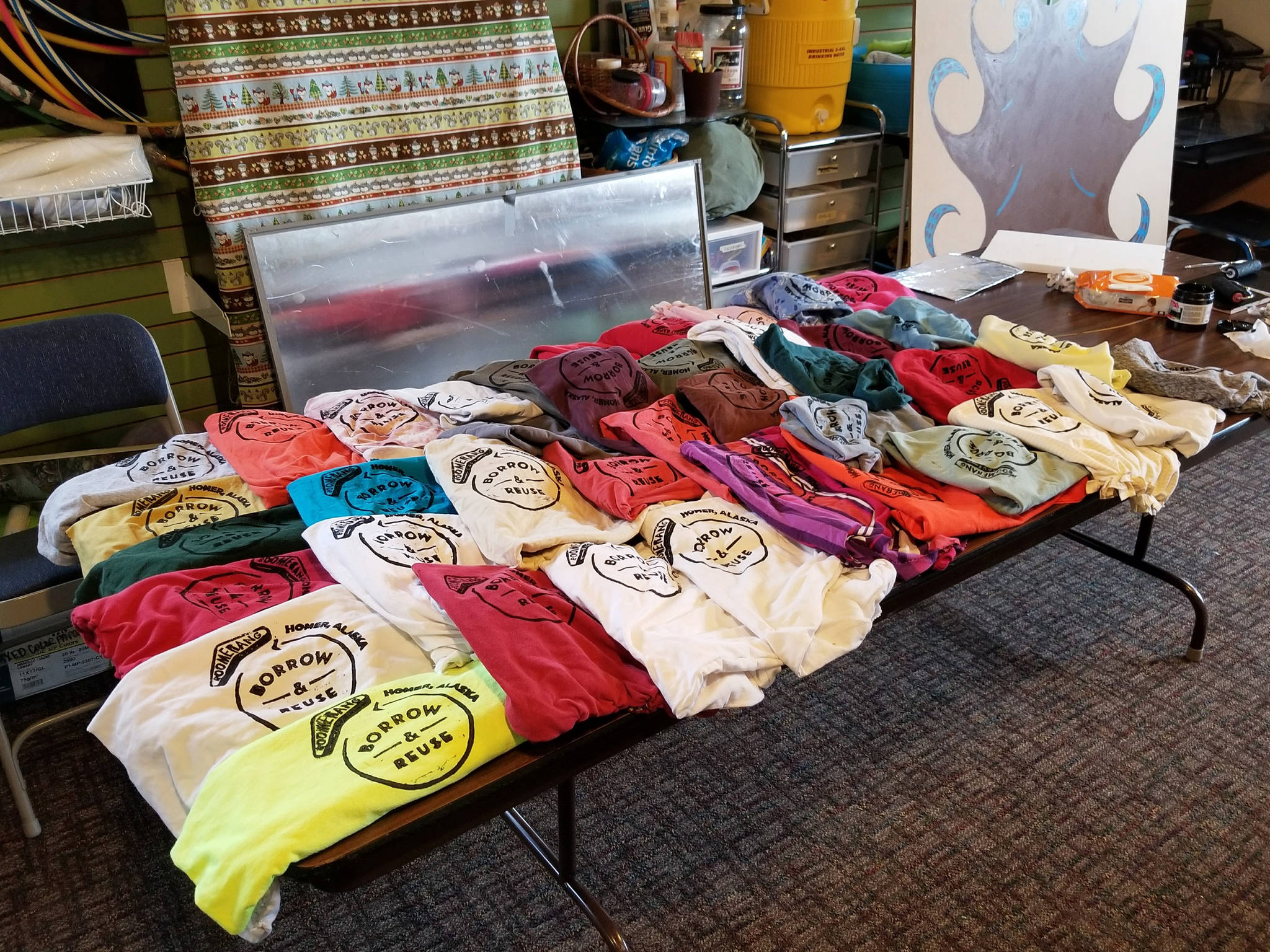Homer’s community of fiber artists — sewers, quilters and crafters who work in fabric and fiber — brought in some new talent over the past two years, and it’s for a good cause.
Since 2017, the Center for Alaskan Coastal Studies has been working with local Girl Scouts to make a cheap, affordable version of reusable shopping bags called Boomerang Bags. With support from adult sewers, the girls have started the first Alaska chapter of Boomerang Bags, an international sustainability movement that originated in Australia in 2013. The organization encourages grassroots efforts in communities to organize people together to make bags out of T-shirts and other materials. The overall goal is to reduce the amount of plastic bags being used in each community.
On Monday night, at least one Girl Scout spoke to the Homer City Council about Boomerang Bags, and council member Caroline Venuti handed out bags to council members and the audience.
Rebecca Trowbridge, a member of Troop 226 and daughter of Beth Trowbridge, executive director of the Center for Alaskan Coastal Studies, spoke about the damage traditional single-use plastic bags can do.
“Plastic bags can pollute our land and water,” she said. “It can trick animals into (thinking it’s) food, especially marine mammals, when it goes into the water. Plastic bags are definitely harmful to humans as well, when they eat fish that have eaten plastic.”
Trowbridge spoke about the many fish that have been found with plastic inside them, and that they can trick sea turtles into thinking they are jellyfish.
Since the project started, sewers have made about 500 bags, and over the summer began distributing them to local stores. They’re now available on Boomerang Bag “trees” at the Center for Alaskan Coastal Studies, Homer Shores, Save-U-More, Homer Bookstore, Sustainable Wares and Captain’s Toy chest.
Boomerang Bags fill a need with the push to encourage visitors and residents to switch from single-use, environmentally detrimental plastic bags to reusable shopping bags. Some people might forget their reusable bags, some might not be able to afford them and some visitors might not have bags. Anyone can take a bag to use, keep it, give it away or return it to Boomerang Bag stands.
“I think in a lot of way it’s changing that mind set to be more of a sustainable mind set and not being a throwaway,” said Beth Trowbridge.
The leader of Girl Scout Troop 226, a junior troop for fifth and sixth graders, Trowbridge and the girls helped start Boomerang Bags in Homer as part of S.T.O.P., Stewards Targeting Ocean Problems, a NOAA Marine Debris Outreach and Prevention funded program with coastal studies. Trowbridge said the girls wanted to look at the problem of single-use plastic bags. Other troops joined Troop 226 in sewing bags.
Boomerang Bags are a low-tech, simple project that makes bags out of old T-shirts, sheets and other fabric. Younger children can make a simple bag by cutting up a T-shirt and tying knots.
“Boomerang bags had directions for making bags out of T-shrits,” Trowbridge said. “… One of the reasons we started with the T-shirts was that was easy for younger girls to do.”
Keagan Niebuhr, 10, is a member of Girl Scout Troop 258 and helped sew and put in stores the Boomerang Bags.
“It was pretty simple,” she said of making the bags. “Basically you just cut off the sleeve, cut off the neck and sew the bottom.”
Niebuhr echoed Rebecca Trowbridge as to why people shouldn’t use single-use plastic bags.
“They can get into the ocean and all the animals can eat it and they can all die,” she said.
Those with more advanced sewing skills can make bags using a template provided by CACS. The Girl Scouts bought old T-shirts at Homer Thrift or used shirts and fabric donated by people.
“The idea is to repurpose things in the community to make these bags,” Trowbridge said.
Sewing bees were set up at the CACS headquarters on Smokey Bay Way using donated sewing machines. Other sewers held their own sewing bees. One of the fun aspects of Boomerang Bags is seeing all the old T-shirts that have cycled through town — shirts for old businesses, shirts from athletic events like the Spit Run and shirts from around the country.
“It was kind of interesting,” Niebuhr said of the T-shirts she saw. “You could see all the different sizes and stuff. Some were ginormous and some were tiny.”
Upcycling old fabric helps reduce environmental costs of resusable bags. Some critics of reusable bags as alternatives to plastic say that the environmental cost of manufacturing and shipping reusable bags should be considered.
“There has been some discussion aobut that,” Trowbridge said. “I think that’s part of the premise of the Boomerang project. You’re repurposing things. It’s not like you’re asking a factory to make more bags. … It’s really only our time and the electricity to run the sewing machines.”
Other community members have been joining the Boomerang Bag project. Marine debris coordinator Henry Reiske has done workshops with elementary school students. Youth in the HOWL outdoor education program did a workshop in the summer. Volunteers made bag trees.
“There’s been a lot of other people,” Trowbridge said. “That’s the whole idea — to get the community engaged.”
The goal is to get more bags and trees to hang and display them made. Interested stores can contact CACS if they want to have bag trees. Trowbridge said having a bag tree at the Homer Community Food Pantry would be a great place to have them.
CACS also will hold sewing bees from 1-4:30 p.m. the third Sunday of each month. Anybody is welcome.
For more information, contact Reiske at the Center for Alaskan Coastal Studies at 907-235-6741, or henry@akcoastalstudies.com.
Reach Michael Armstrong at marmstrong@homernews.com.


